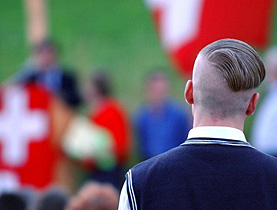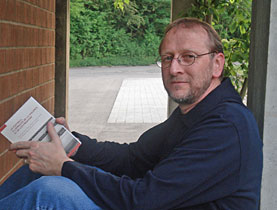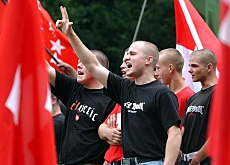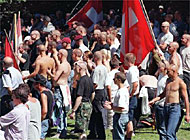Rightwing extremism on the rise

Skinheads and other extremists are a small but growing group in Switzerland, where researchers say one in three people is xenophobic and one in five anti-Semitic.
But the far right remains fractured and weak, with just 1,200 active members, according to the national research programme findings.
Overall, that’s about on par with Germany and the rest of Europe.
“Although extremism is on the rise, it is not at a level where it would be an immediate threat to democratic society,” said Marcel Niggli, president of NRP40+, which presented the findings in Bern on Tuesday.
Niggli was one of four researchers who discussed the results of 13 studies commissioned by the government after neo-Nazis disrupted a festival on August 1, 2000 marking the founding of the Swiss confederation.
The SFr4-million ($3.45-million) project is the first to take a comprehensive look at the social profiles of members of rightwing groups, their victims and the role the media plays in how society responds to these acts.
The researchers also wanted to put Switzerland’s rightwing extremists into an international context for comparison. Recommendations on how to combat the problem, however, could prove to be difficult.
“There isn’t a measure you can do to say tomorrow it will no longer exist,” said Sandro Cattacin, a project leader.
Skinhead history
Rightwing extremism has changed throughout the years in Switzerland from a limited underground movement at the end of the Second World War into a larger subculture today, according to Damir Skenderovic, author of one of the 13 studies.
Skenderovic says that the transformation accelerated during the mid-1980s during the “Small Springtime of Fronts” when young skinheads took more public roles. Some groups were highly organised propagandists that rallied around a single leader while others were little more than gangs that drank at the same bar.
But their impacts were clear. Statistics show that between 1988 and 1993 members of the extreme right committed 378 violent acts, assaulting immigrants, burning asylum seekers’ lodgings and threatening opponents. Fourteen people were killed and 145 people were injured.
“Given the size of the population, the number of deaths in Switzerland has been far higher, proportionately, than in Germany,” Skenderovic wrote.
Today the situation has grown considerably worse. Police figures estimate there are about 1,200 active rightwing extremists in Switzerland, a 30 per cent increase since 2000 and a 336 per cent leap since 1997. They have committed more than 990 violent acts between 1997 and 2007.
“In a more globalised society like we have today, that isn’t really surprising,” Niggli said. “But it is nevertheless valuable to know that there is a rather important group that does not accept one of the foundations of democracy, the equality of men.”
Family violence
Starting around 1985 the media began to report more frequently on random acts of violence committed by skinheads and hooligans. Today that trend continues.
Some researchers said the media had become “hysterical” with such stories – as with the recent case of a Brazilian woman who falsely claimed to have been attacked by Neo-Nazis in Zurich. That kind of reporting can be dangerous because emotions hinder rational dialogue and can lead to more violence, they said.
The presenters were reluctant to speculate on the reasons why extremism is on the rise in Switzerland because the studies presented on Tuesday were the first comprehensive body of work for the country on the subject. Instead, the project was intended to provide a snapshot of the situation now.
Thomas Gabriel, a project leader from Zurich University, looked at the relationship between extremists and their upbringing.
“There are several influences and life circumstances that have to come together,” he said. “What we found was a link to conservative or rightwing attitudes and violence within the family. Another development path is a juvenile trying to get attention.”
Contrary to some opinions, Gabriel said such youths and their families have not been left out of modern society and that social marginalisation plays only a minor role in the evolution of a skinhead. Rather, it’s the social network and family itself that influences their development.
Of 26 cases his group looked at, 77 per cent of the extremists were male with an average age of 18, though half were under 20. More than 50 per cent belonged to a political organisation, like the Swiss Hammerskins or the Party of Nationally Oriented Swiss (PNOS).
Islamophobia
While far-right activities may be proportionate with the rest of Europe, Switzerland does breed its own variety of extremist.
According to a survey of 3,056 people from three of the country’s language regions, nearly one in three Swiss are Islamophobes. More shocking is sexism, where 40 per cent of the population does not agree entirely with gender equality. Seven per cent believes violence can solve problems.
But extreme rightwingers are in no position to hurt Switzerland’s democracy because those groups tend to be marginalised and not in government, said Cattacin, who looked at monitoring extremist attitudes. Switzerland’s biggest political group, the Swiss People’s Party, is considered rightwing but it is hardly extreme.
Nevertheless that party helps to vent at least some steam for other, far more radical groups by championing conservative stances on immigration and asylum, for example. Giving a voice to everyone is critical to a democracy, he added.
“Switzerland has to work on the public space to give all positions a way to express themselves,” Cattacin said.
swissinfo, Tim Neville
Most likely areas for rightwing violence:
On the bus, train, or while waiting for either: 24.7%
On the street: 22.6%
At a party: 18.3%
In the forest, park, at the lake: 8.1%
In September 2000, one month after skinheads disrupted a national ceremony above Lake Lucerne, the Justice Office asked the government to intensify research on rightwing extremism. The Swiss National Science Foundation carried out that request.
With a budget of SFr4 million, the foundation commissioned 14 research projects ranging from how extremism is born to looking at the role of football stadiums as a place for rightwing extremists to gather and recruit. Thirteen of the projects were completed by 2007. The results are published in a 300-page report.
Radicals and extremists are not interchangeable terms. In the study, a radical was defined as a group that accepts the rules of a democracy but challenges its basis by being particularly cool to the ideas of pluralism.
Extremists, however, generally mistrust and reject the democratic process. Therefore, the researchers argue, a political party cannot be made of rightwing extremists but may be made of rightwing radicals, as long as that party abides by the rules of the game, even if its goal is to do away with democracy.
That brings up a conundrum: How tolerant should a democracy be toward groups that wish to abolish democracy?

In compliance with the JTI standards
More: SWI swissinfo.ch certified by the Journalism Trust Initiative






You can find an overview of ongoing debates with our journalists here. Please join us!
If you want to start a conversation about a topic raised in this article or want to report factual errors, email us at english@swissinfo.ch.